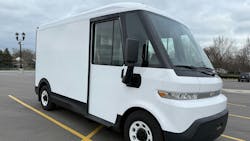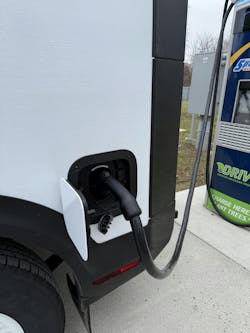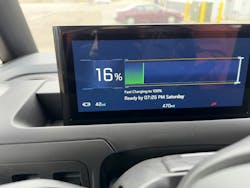Driving an electric cargo van vs. ICE cargo van
Range is the most significant talking point when comparing electric vehicles to those powered by internal combustion engines, but other differences must also be considered. Did you know that not all public chargers are created equal? What is one-pedal driving? FleetOwner recently had a chance to review the battery-electric Chevrolet BrightDrop, and we’re here to report the differences between it and an ICE cargo van.
What’s the deal with EV range?
Like fuel mileage, range is dependent upon multiple factors. But unlike traditional fuels that can be topped off at any local fueling station, EVs require a charging station, which are more challenging to find and take longer than refueling. This can lead to “range anxiety,” or the feeling that the driver will deplete the electric vehicle’s battery before completing their work.
While this is a possibility, with proper planning, electric vehicles are well-suited for last-mile delivery applications due to their low average of miles driven per day and constant stop-and-go operations, leading to regenerative braking that helps replenish lost energy.
See also: Chevrolet BrightDrop 400 review: An EV built for delivery
FleetOwner drove the BrightDrop in both urban settings and on the highway. Here’s how it affected the range:
When FleetOwner received the BrightDrop, its battery was 75% charged. During the week the vehicle was tested, the vehicle was not charged at a home charger. It was also parked on the street throughout the week, while temperature lows were in the 20s. While one morning, the BrightDrop’s battery life was one percent less than the night before when it was parked, the temperature’s effect on the battery was insignificant.
FleetOwner drove about 130.5 miles throughout the week and saw the battery life of 75% drop to roughly 15%. While most of these trips were within town using regenerative braking, three highway trips were taken, accounting for most of the mileage on the vehicle.
FleetOwner took the BrightDrop about an hour out—almost exclusively on the interstate. At this point, the battery life was around 15%, requiring a recharge before returning. Finding public charging wasn’t a problem.
However, only a Level 2 charger with a kilowatt output of 62.5 kW was available.
Chevrolet claims its BrightDrop offers up to 160 miles of range per hour of charge via a 120-kW DC fast charger, which sounds ideal if you find yourself low on charge and in a pinch. But if you’re familiar with EVs, you might already know that public charging stations vary on electricity output, unlike traditional fueling stations that offer similar products. Depending on where you charge and whether DC fast charging is offered, the time it takes to get to a range of 160 miles could vary significantly. FleetOwner’s BrightDrop test is a prime example.
After charging for one hour using a Level 2 62.5 kW charger, the battery reached around 35%, or a range of about 75 miles. Using assistance from Google Maps to determine how much battery life would be left after reaching the destination (an estimated 10%), it was determined that 35% battery life would be sufficient to start the journey back. Instead of driving straight to the destination, the van was taken immediately to another public charger to prepare for the next few days when the vehicle would be tested.
Similar to an ICE vehicle’s mpg, an EV’s actual range depends on multiple factors. With battery-electric vehicles, these factors include payload, temperature, terrain, how fast or aggressive you drive, the battery’s age, and how well the vehicle is maintained.
Another aspect of EVs that can affect range is their one-pedal driving mode.
See also: How fleets can choose the right alternative powertrain
One-pedal driving
The biggest difference in driving the Brightdrop compared to other cargo vans is its one-pedal driving mode. This can be toggled off, but it might be preferable to drivers and fleet owners to increase range through regenerative braking.
However, one-pedal driving does take a few loops around the block to get used to. For those who have never driven in one-pedal drive mode, when you lift your foot off the accelerator, the vehicle immediately begins to decelerate, feeling as if you’re actively pressing the brake pedal. With one-pedal driving, you will come to a full stop without touching the brake pedal—and that stop has the potential to feel quite abrupt. If you don’t ease off the accelerator gently, you and your passenger will lunge forward, and in the BrightDrop’s small passenger jump seat, your passenger will really want to make sure they’re wearing their seat belt.
FleetOwner found one-pedal driving more preferable as it seemed to simplify the driving process. Any time you can reduce a step—in this case, braking—is a win.
BrightDrop’s acoustic vehicle alerting system
EVs also have another aspect to them that ICE vehicles don’t–and that’s a sound engineering team.
These sound engineering teams create artificial sounds for the EVs. This is because of government requirements. Hybrids and EVs operate so quietly at low speeds, therefore, governments across the globe require hybrid and EV manufacturers to add an audible sound to increase safety among pedestrians that might not otherwise hear the vehicle coming. Different OEMs refer to this sound differently, but GM refers to it as an “acoustic vehicle alert system.”
The BrightDrop’s AVAS is a bright-sounding hum that the BrightDrop emits at low speeds. The Chevrolet Brightdrop’s AVAS begins to sound when the vehicle is turned on and ceases to sound once it hits 22 to 25 mph.
See also: First look: Ram shows off its new last-mile EV
An electric cargo van has differences from an ICE cargo van that are immediately noticeable. Operators must keep an eye on range and plan accordingly. If one-pedal driving mode is to be used, it takes practice. And, of course, the AVAS—while it doesn’t require “getting used to”—it is something that is completely different from a traditional cargo van.
These differences should not cause fleet owners to shy away from EVs, however, as their practicality and function align well—if not more so—to traditional vehicles in last-mile delivery applications.
About the Author
Jade Brasher
Senior Editor Jade Brasher has covered vocational trucking and fleets since 2018. A graduate of The University of Alabama with a degree in journalism, Jade enjoys telling stories about the people behind the wheel and the intricate processes of the ever-evolving trucking industry.



